



Case Studies
The following Case Studies are part of the Thinking Foundations collaboration with schools and school districts for ongoing research.
St. Robert of Newminster Catholic School and Sixth Form College: Thinking Maps and School Effectiveness
United Kingdom
June 2009
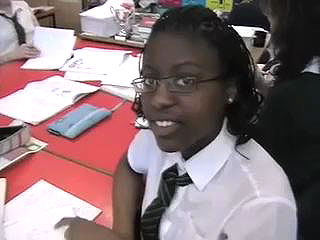 The results of our lesson observations demonstrate that the use of Thinking Maps® facilitate a greater percentage of time spent on activities that promote higher order thinking. Although 16 lessons constitute a relatively small sample, these results are encouraging and suggest that where Thinking Maps® are being used, students have more consistent access to higher order thinking skills.
The results of our lesson observations demonstrate that the use of Thinking Maps® facilitate a greater percentage of time spent on activities that promote higher order thinking. Although 16 lessons constitute a relatively small sample, these results are encouraging and suggest that where Thinking Maps® are being used, students have more consistent access to higher order thinking skills.
Staff evaluations of previous and current teaching methodologies demonstrated that existing effective pedagogical practices remain integral to the lesson. However, staff indicated that the implementation of Thinking Maps® has enhanced their effectiveness by developing: a common thinking tool used for purpose; students’ access to a more effective planning tool; the sharing and visualisation of thinking. As previously concluded, staff indicate that the use of Thinking Maps® facilitate higher order thinking skills.
![]() Go to the St Robert School Case Study
Go to the St Robert School Case Study
Mckinley Elementary School
San Jose, California
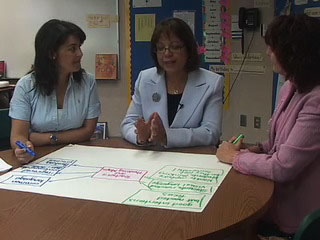 November 2007, June 2009
November 2007, June 2009
It is the intent of this study to examine the role of Thinking Maps® in the transformation of teacher effectiveness. In addition we will analyze how the use of the common visual language provided by Thinking Maps has facilitated teacher collaboration and communication within and across grade levels.
![]() Go to the McKinley Elementary School Case Study Year 1
Go to the McKinley Elementary School Case Study Year 1
![]() Go to the McKinley Elementary School Case Study Year 2
Go to the McKinley Elementary School Case Study Year 2
Learning Prep
West Newton, MA
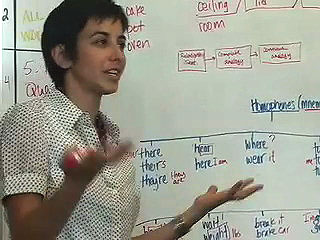 December 2007
December 2007
Since September 2002, student performance at this school has improved as demonstrated by an increase in vocabulary acquisition, concept attainment, an ability to make connections, and an ability to establish relationships. The students' overall learning process has been facilitated by the use of these visual tools. Using Thinking Maps, students have been able to develop cognition and comprehension 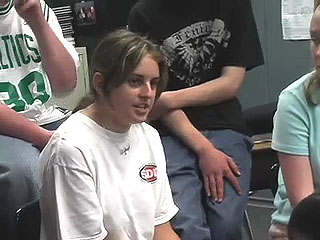 strategies in order that they may bridge the gap between current and projected abilities. As evidenced by the 2002 MACS Retest scores, Thinking Maps have proven to be an integral tool for students to retain and retrieve content, attain concepts, and forge connections. Teachers' fluency with Thinking Maps is tracked as well, to ensure that students are receiving the maximum benefit possible.
strategies in order that they may bridge the gap between current and projected abilities. As evidenced by the 2002 MACS Retest scores, Thinking Maps have proven to be an integral tool for students to retain and retrieve content, attain concepts, and forge connections. Teachers' fluency with Thinking Maps is tracked as well, to ensure that students are receiving the maximum benefit possible.
![]() Go to the Learning Prep School Case Study
Go to the Learning Prep School Case Study
Blackham School
Bridgeport Public Schools, Bridgeport, CT
September 2009
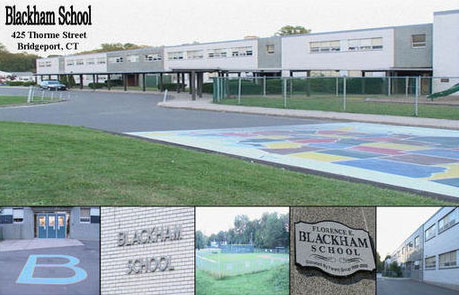 We are encouraged by the growth of our strong professional learning community, empowering teachers as leaders via the Vertical Data Team, and initiating the use of Thinking Maps as a strategy to organize and communicate goals and objectives for the school. We feel the Maps have helped drive instruction and have had a direct impact on student learning. While exploring the use of these maps, we have tailored them to be applicable to our needs. There were a few occasions where the team felt frustrated or limited in choosing which Map would be most affective in a given situation. Trial and error allowed us the opportunity to learn from our mistakes and move forward.
We are encouraged by the growth of our strong professional learning community, empowering teachers as leaders via the Vertical Data Team, and initiating the use of Thinking Maps as a strategy to organize and communicate goals and objectives for the school. We feel the Maps have helped drive instruction and have had a direct impact on student learning. While exploring the use of these maps, we have tailored them to be applicable to our needs. There were a few occasions where the team felt frustrated or limited in choosing which Map would be most affective in a given situation. Trial and error allowed us the opportunity to learn from our mistakes and move forward.
![]() Go to the Blackham School Case Study
Go to the Blackham School Case Study
Roosevelt Elementary School: A First Language for Thinking in a Multilingual School
Long Beach, CA
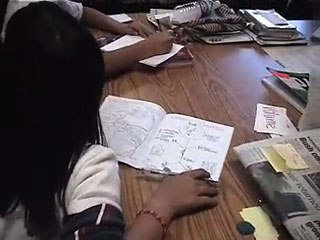 My intent as the instructional leader of Roosevelt School [Stefanie R. Holzman, Ed.D.] was initially isolated on these tools for a direct and immediate impact on student performance. What I didn't realize and could not foresee were the deeper effects upon the development of teachers across our year-round, multitrack school as a result of the use of Thinking Maps in their classrooms. Read about Roosevelt Elementary School including video clips and test data.
My intent as the instructional leader of Roosevelt School [Stefanie R. Holzman, Ed.D.] was initially isolated on these tools for a direct and immediate impact on student performance. What I didn't realize and could not foresee were the deeper effects upon the development of teachers across our year-round, multitrack school as a result of the use of Thinking Maps in their classrooms. Read about Roosevelt Elementary School including video clips and test data.
![]() Go to the Roosevelt Elementary School Case Study
Go to the Roosevelt Elementary School Case Study
Ethiopia Thinking Schools Professional Development
Addis Ababa, Ethiopia, Africa
August 2009
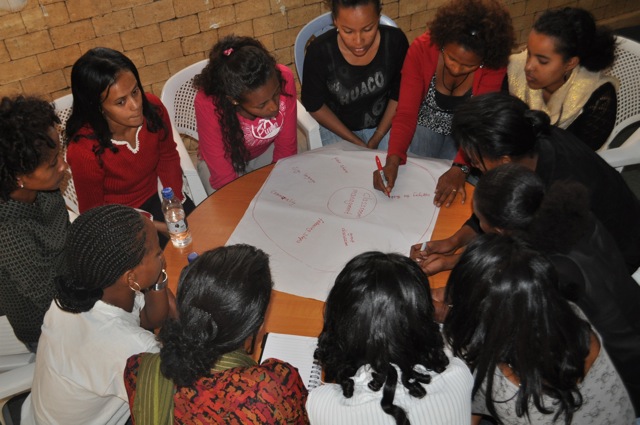 The Thinking Schools professional development model is structured upon three areas of learning: Community Building, Reflective Practice, and Systems Thinking. The ultimate goal is to create a sustainable Thinking School and cohesive collaborative school community.
The Thinking Schools professional development model is structured upon three areas of learning: Community Building, Reflective Practice, and Systems Thinking. The ultimate goal is to create a sustainable Thinking School and cohesive collaborative school community.
A goal of the initial professional development training from 24-28 August 2009 was to provide hands-on sessions with visual tools (cognitive visual maps), inquiry, community building, systems thinking with the whole education community, the physical classroom environment, and making decisions with intentionality. Based on feedback during and after the 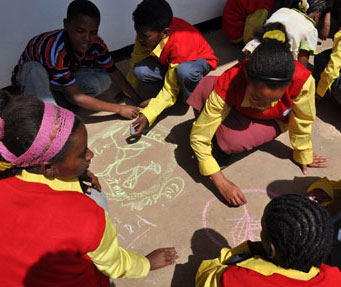 five day professional development held in Addis Ababa during August 2009, the learning outcomes were achieved and surpassed.
five day professional development held in Addis Ababa during August 2009, the learning outcomes were achieved and surpassed.
The second professional development sessions were held in January 2010 including sessions for educators in Addis Ababa and Hossana Ethiopia. A leadership for educators and NGO leaders was held in Addis Ababa.
The professional development continues with workshops with educators, educational leaders, and NGO leaders during May 2010.
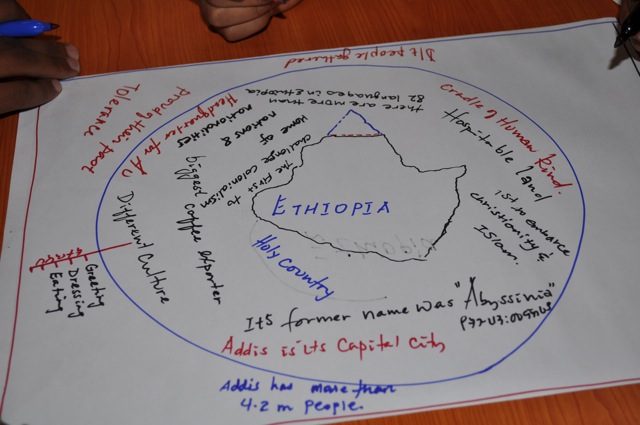 The CHSFS Ethiopia schools and staff, physical facilities and professional video crew are well positioned to create a thriving high quality model laboratory school. This model would initially include the CHSFS schools, and ultimately expand to other participating schools and regions including the state (public) schools. The latter, incorporating state schools, was noted as very feasible by the UNESCO Institute of Capacity Building (www.unesco-iicba.org) director Awol Endis who participated in the week long Thinking Schools professional development in August 2009.
The CHSFS Ethiopia schools and staff, physical facilities and professional video crew are well positioned to create a thriving high quality model laboratory school. This model would initially include the CHSFS schools, and ultimately expand to other participating schools and regions including the state (public) schools. The latter, incorporating state schools, was noted as very feasible by the UNESCO Institute of Capacity Building (www.unesco-iicba.org) director Awol Endis who participated in the week long Thinking Schools professional development in August 2009.
Mt. Airy Elementary School
Mt. Airy, Maryland
Topics to be discussed:
- linking reading text structure research to cognitive patters
- results from first graders' fluency with Thinking Maps®
- multiple Thinking Maps® applied to phonics, vocabulary and reading comprehension
While I am reading, my mind adds Thinking Maps all by itself, and suddenly I know more than I knew!
(student in Cristina Smith's first-grade class, Mr. Airy School, Maryland)
 At Mt. Airy Elementary School, in a classroom of first-grade studetnts, on a morning in mid-May, we watched as a third-year teacher read the guiding question for the day: "how will you organize your thinking about this book?" While this may seem to be an unfocused question, the teacher knew the students could meaningfully respond. The book, How Leo Learned to Be King, rested on the chalkboard tray with its colorful picture of a crowned lion on the cover, set there after it had been read aloud the day before. This is an inclusive classroom of students in a modest suburban neighborhood school, a school that had experienced a 15% decline in writing scores over the previous two years and mediocre reading scores as the population swelled beyond the original building and into portables.
At Mt. Airy Elementary School, in a classroom of first-grade studetnts, on a morning in mid-May, we watched as a third-year teacher read the guiding question for the day: "how will you organize your thinking about this book?" While this may seem to be an unfocused question, the teacher knew the students could meaningfully respond. The book, How Leo Learned to Be King, rested on the chalkboard tray with its colorful picture of a crowned lion on the cover, set there after it had been read aloud the day before. This is an inclusive classroom of students in a modest suburban neighborhood school, a school that had experienced a 15% decline in writing scores over the previous two years and mediocre reading scores as the population swelled beyond the original building and into portables.
![]() Go to the Mt. Airy Elementary School Case Study
Go to the Mt. Airy Elementary School Case Study